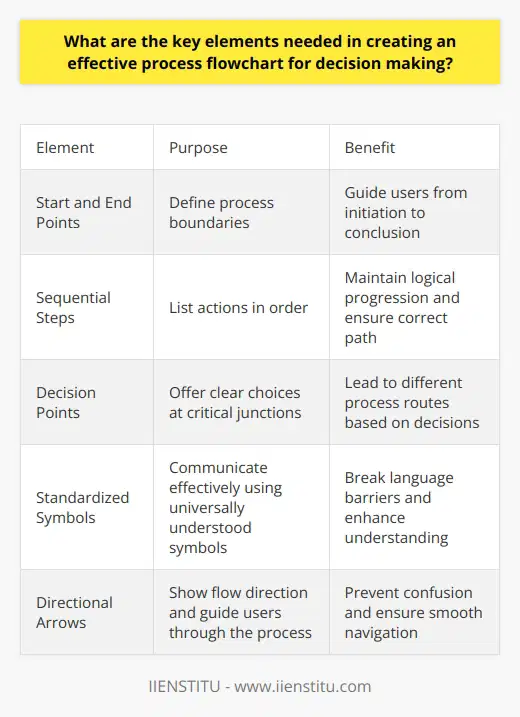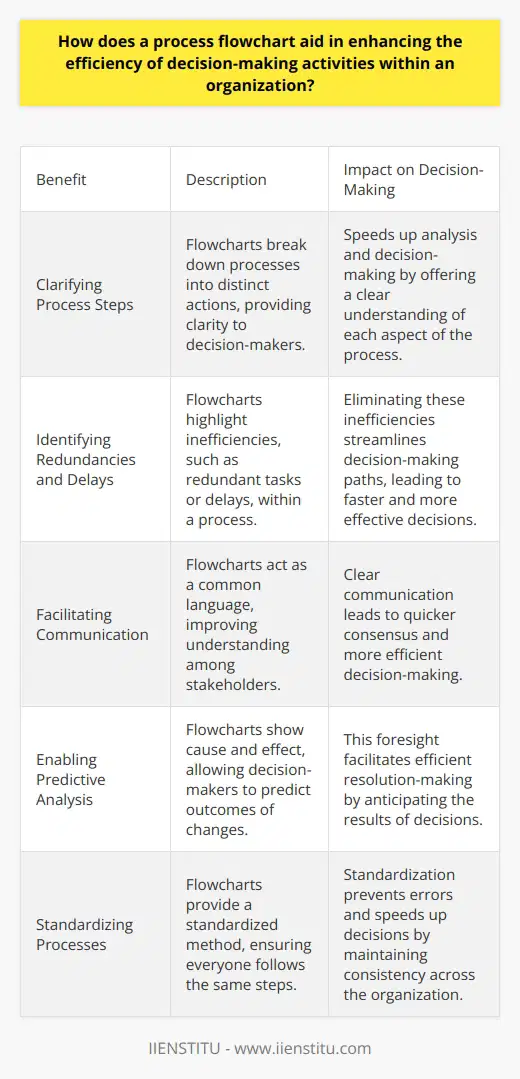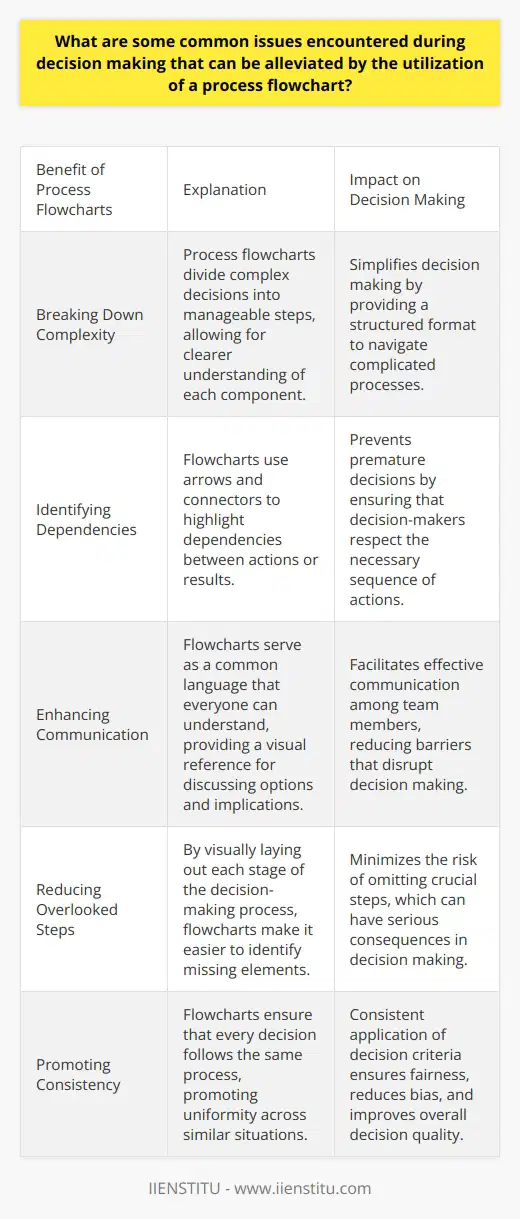
I still remember the day when I was staring at a complex process in our company, feeling utterly overwhelmed. Deadlines were looming, and our team was struggling to keep up with the workflow. That's when a colleague introduced me to the world of process flowcharts. Little did I know, this simple tool would become a game-changer in how I approached problem-solving and decision-making.
Understanding and utilizing process flowcharts not only streamlined our operations but also empowered each team member to grasp the bigger picture. In this blog post, I'd like to share my experiences with process flowcharts, shedding light on their anatomy, creation, and real-life applications. Whether you're new to the concept or looking to deepen your understanding, I hope my journey offers valuable insights.
Understanding the Heart of Process Flowcharts
Before diving into the nitty-gritty of creating flowcharts, it's essential to understand what they are and how they function. For me, grasping the fundamentals was the first step toward leveraging this tool effectively.
My First Encounter with Flowchart Symbols
The initial challenge I faced was deciphering the various flowchart symbols. It felt like learning a new language. Rectangles, diamonds, ovals—each had a specific meaning. For instance, rectangles represent process steps or activities, which was intuitive once I thought about it. Diamonds indicate decision points, requiring a yes/no response, and ovals signify the start or end of a process.
I recall a project where misinterpreting a symbol led to a significant misunderstanding among team members. We had used a parallelogram, typically representing inputs or outputs, instead of a rectangle for a process step. This small error caused confusion about responsibilities and delayed the project's progress. That experience taught me the importance of standardization and clarity in using symbols.
Connecting the Dots: Arrows and Their Significance
If symbols are the words of the flowchart language, then arrows are the grammar that connects them. They show the direction and flow of the process, guiding you from one step to the next. In my early attempts, I underestimated the importance of arrows, often drawing them haphazardly. This led to messy diagrams that were hard to follow.
One technique I found helpful was to think of arrows as the narrative thread of the story I'm trying to tell through the flowchart. By ensuring they flow logically and without unnecessary overlaps, the process becomes much clearer. In collaborative settings, this clarity prevents miscommunication and keeps everyone on the same page.

Steps I've Taken to Create Effective Flowcharts
Creating a process flowchart isn't just about knowing the symbols and arrows; it's about thoughtfully applying them to represent a process accurately. Over time, I've developed a methodical approach that has served me well.
Choosing the Right Process: Lessons Learned
Not every process needs a flowchart. Early on, I made the mistake of trying to chart out overly simplistic procedures, which wasted time and offered little value. Now, I focus on processes that are complex, involve multiple stakeholders, or have inefficiencies that need addressing.
For example, our customer service department was experiencing delays in resolving complaints. By flowcharting the entire customer complaint process, we identified redundant steps and communication gaps. This visual representation made it easier to pinpoint where improvements were needed, leading to faster resolution times and increased customer satisfaction.
Organizing Steps: Avoiding Common Pitfalls
Organizing process steps is akin to assembling a puzzle. Each piece must fit perfectly for the whole picture to make sense. I learned to start by listing all the steps involved without worrying about the order. Then, I arrange them logically, often involving team members to ensure accuracy.
A common pitfall I encountered was assuming I knew the process entirely. Once, while charting the procurement process, I overlooked the approval step required by the finance department. This omission could have led to compliance issues. Engaging with all stakeholders helped me create a comprehensive and accurate flowchart.
Drafting and Redrafting: The Art of Flowchart Creation
The first draft is rarely perfect. I've come to appreciate the iterative nature of creating flowcharts. Initial sketches often evolve significantly before reaching the final version. Using flowcharting software has made this process smoother, allowing for easy adjustments and professional-looking diagrams.
However, there's something to be said for starting with pen and paper. The tactile experience of drawing each symbol and arrow helps me think more critically about each step. Once I'm satisfied with the manual draft, I transition to digital tools for refinement.

Real-Life Applications: Flowcharts in Action
Seeing the tangible benefits of flowcharts in real-world scenarios has reinforced their value in my toolkit. Let me share a couple of instances where flowcharts made a significant difference.
Case Study: Streamlining Our Team's Workflow
Our marketing team was struggling with content approval delays, affecting our publishing schedule. We decided to map out the entire content creation process using a flowchart. The visual layout highlighted that drafts were going through unnecessary rounds of revisions due to unclear guidelines.
By adjusting the process—implementing a standardized briefing template and setting clear revision limits—we reduced the content turnaround time by 30%. The flowchart served as a reference point for everyone involved, ensuring we adhered to the new, more efficient process.
Embracing Continuous Improvement
Flowcharts aren't static documents; they should evolve with your processes. In another instance, we used a flowchart to onboard new employees. Feedback revealed that the training modules were overwhelming when presented in a linear fashion. By revising the flowchart to include parallel paths for certain training components, new hires could manage their learning pace better, resulting in a smoother onboarding experience.
Reflecting on my journey with process flowcharts, I realize they've been more than just a tool—they've become a lens through which I view and improve workflows. By breaking down complex procedures into digestible visual steps, I've been able to enhance efficiency, foster better communication, and make more informed decisions.
If you're grappling with convoluted processes or seeking ways to optimize your workflow, I encourage you to give flowcharting a try. Start with a process you know well, involve your team, and be open to iterative improvements. The clarity and insights you gain might just be the catalyst for significant positive change in your organization.
Feel free to share your experiences or ask questions in the comments below. Let's navigate the world of process flowcharts together!
Frequently Asked Questions
What are the key elements needed in creating an effective process flowchart for decision making?
Understanding Process Flowcharts
Process flowcharts serve as visual aids. They simplify complex processes. They aid in decision-making. An effective chart needs several key elements.
Start and End Points.
Mark these clearly. They define process boundaries. They guide users from initiation to conclusion.
Sequential Steps.
List actions in order. This maintains logical progression. It ensures users follow the correct path.
Decision Points.
Include these at critical junctions. They offer clear choices. They lead to different process routes.
Standardized Symbols.
Use universally understood symbols. They communicate effectively. They break language barriers.
Directional Arrows.
Incorporate arrows to show flow direction. They guide users through the process. They prevent confusion.
Designing for Clarity
Simplicity is crucial. Avoid clutter. It enhances understanding.
Consistency matters. Apply symbols uniformly. It ensures predictability.
Readability is key. Choose font styles wisely. They affect legibility.
Precision is important. Ensure accuracy in steps. It removes ambiguity.
Enhancing Decision Making
Clear Objectives.
Define the flowchart purpose. It aligns with decision-making goals. It focuses user attention.
Relevant Information.
Incorporate necessary data. It supports informed decisions. It eliminates guesswork.
Contingency Plans.
Account for uncertainties. They provide alternative actions. They increase process resilience.
Feedback Loops.
Create mechanisms for review. They encourage continuous improvement. They optimize decision making.
Process Flowchart Considerations
Stakeholder Input.
Seek diverse perspectives. They enrich the process design. They address varied needs.
Testing and Iteration.
Test the flowchart for usability. Refine it based on feedback. Iterate for perfection.
Documentation and Training.
Provide clear instructions. Train users thoroughly. It ensures effective implementation.
Review and Update.
Revise the flowchart as needed. It keeps the process current. It maintains relevancy.
In Conclusion
An effective process flowchart is clear, simple, and precise. It must guide users decisively. It should improve decision-making. Keep these elements in mind. They will craft a tool that truly benefits its users.

How does a process flowchart aid in enhancing the efficiency of decision-making activities within an organization?
Understanding Process Flowcharts
A process flowchart represents a sequence of steps. It visualizes how tasks interconnect within a process. Organizations use flowcharts to understand complex processes better.
Enhancing Decision-Making Efficiency
Clarifying Process Steps
Flowcharts break down processes into distinct actions. Decision-makers see each aspect clearly. This clarity speeds up analysis.
Identifying Redundancies and Delays
Flowcharts highlight inefficiencies. Users spot redundant tasks or delays. Eliminating these parts streamlines decision-making paths.
Facilitating Communication
Flowcharts act as a common language. They improve understanding among stakeholders. Clear communication leads to quicker consensus and decisions.
Enabling Predictive Analysis
Flowcharts show cause and effect. Decision-makers predict outcomes of changes. This foresight facilitates efficient resolution-making.
Supporting Training and Onboarding
New team members learn processes through flowcharts. This reduces training time. Efficient learning translates into efficient decision-making.
Standardizing Processes
Flowcharts provide a standardized method. Everyone follows the same steps. Standardization prevents errors and speeds up decisions.
Prioritizing Problem-Solving
By visualizing bottlenecks, flowcharts focus efforts. Teams address critical issues first. This prioritization ensures efficient issue resolution.
Aiding in Resource Allocation
Flowcharts display resource involvement. They assist in optimal resource distribution. Proper allocation enhances overall decision-making capabilities.
Improving Continuous Improvement
Flowcharts form baselines for processes. They track changes over time. Continuous improvement becomes integral to decision-making.
Mitigating Risks
Risk identification becomes easier with flowcharts. Organizations foresee potential problems. Anticipating risks leads to proactive decisions.
Conclusion
Process flowcharts serve as essential tools. They transform complex procedures into understandable visuals. This enhances the efficiency of organizational decision-making significantly.

What are some common issues encountered during decision making that can be alleviated by the utilization of a process flowchart?
Decision Making and Process Flowcharts
Decision making in both business and personal contexts often involves complex considerations. Without structured tools, individuals and teams may face several common issues. Process flowcharts serve as such tools, offering a visual method to map out each step involved in reaching a decision.
Understanding Complexity
Complex problems often have many moving parts. Process flowcharts break down complex decisions into manageable steps. Individuals can thus view each component more clearly. These visual aids help to demystify complicated processes by presenting them in a structured format.
Identifying Dependencies
Some decisions rely on preceding actions or results. Flowcharts highlight these dependencies with arrows and connectors. This visualization can prevent premature decisions. It ensures that decision-makers respect the necessary sequence of actions.
Improving Communication
Communication barriers disrupt effective decision making. Flowcharts act as a common language that everyone can understand. With a visual reference, teams find it easier to discuss options and implications.
Reducing Overlooked Steps
Omitting a step can have serious consequences. A process flowchart reduces this risk by laying out each stage of the decision-making process. As each step appears visually, missing elements become more evident.
Enhancing Collaboration
Collaborative decision making can be chaotic with diverse viewpoints. Process flowcharts align team members by providing a clear roadmap. Ultimately, this encourages shared understanding and teamwork.
Streamlining Decision Making
Efficiency is crucial in decision-making processes. Flowcharts promote a faster resolution by outlining the most direct path to a decision. Redundancies and inefficiencies thus become easy to spot and correct.
Creating a Record
Flowcharts also act as documentation for decision pathways. This record can be useful for future reference or training. It ensures that successful decision-making processes can be replicated.
Promoting Consistency
Consistent application of decision criteria ensures fairness and reduces bias. Flowcharts ensure that every decision follows the same process. This uniformity promotes fairness across similar situations.
Facilitating Analysis
After a decision, analysis is key to improvement. Flowcharts lay a foundation for dissecting what worked and what did not. Teams can use them to refine future decision-making processes.
In conclusion, process flowcharts can significantly alleviate common decision-making issues. They bring clarity, structure, and efficiency to the process. By implementing a visual and systematic approach, decision-makers can avoid the pitfalls that typically hinder optimal outcomes.


